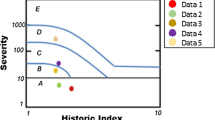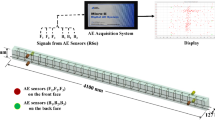Abstract
The Acoustic Emission (AE) phenomenon is extensively studied for beams, columns and bridges. A breadth of literature is available interpreting the AE activity to monitor the structural health of elements and materials, quantify their damage, and predict failure. However, there is few information on its applicability and limitations regarding the Concrete Capacity Design (CCD) method of designing anchorage to concrete, which lies at the core of all the design practices. A cast-in anchorage to concrete under tensile force was designed as per the stipulations of CCD and parametric analyses of the AE signal, recorded during the pulling-out of the anchor rod, were conducted through pull-out tests. The damage was evaluated from the pull-out stiffness variation and the work done by the tensile force. The AE b-value, relaxation ratio, calm ratio, and load ratio analyses were performed to investigate suggestive trends regarding the damage and loading conditions. At load levels close to failure, the stiffness decline was accompanied by an increase in work done calculated by the load versus pull-out displacement. The Kaiser effect existed at load cycles lower than the concrete breakout strength and the b-value was also lower than one. The histogram of damage quantification, standardized by the Japanese Society of Nondestructive Inspection (JSNDI), was developed to determine the damage and establish boundaries among the damage levels. The relaxation ratio also implied damage occurring because of dominant AE activity during unloading when the applied load was more than the concrete breakout strength. It was found that complete unloading is necessary to obtain correct results with relaxation ratio. AE was found promising to investigate the behavior of anchor systems with few discrepancies.













Similar content being viewed by others
References
Rajapakse R (2008) 24 - Rock bolts, dowels, and cable bolts. Geotechnical engineering calculations and rules of thumb. Butterworth-Heinemann, Oxford, pp 303–320
Kulak GL, Undershute ST (1998) Tension control bolts: strength and installation. J Brg Eng 3:15–20. https://doi.org/10.1061/(ASCE)1084-0702(1998)3:1(15)
Cook R, Burtz JL, Ansley MH (2003) Design guidelines and specifications for engineered grout. National Technical Information Service, Virginia
Eligehausen R, Mallée R, Silva JF (2006) Anchorage in concrete construction. Ernst & Sohn, Darmstadt, pp 5–30
Fuchs W, Eligehausen R, Breen JE (1995) Concrete capacity design (CCD) approach for fastening to concrete. ACI Struct J 92:73–94. https://doi.org/10.14359/1533
ACI 349 (2001) Code requirements for nuclear safety related concrete structures & commentary, (ACI 349–01, ACI 349R-01), Appendix B (2001, American Concrete Institute, (Farmington Hills, Mich) pp. 134
ACI Committee 318 (2019) Anchoring to concrete. In: building code requirements for structural concrete, Indianapolis: American Concrete Institute, pp. 221–260
Rolf E et al (1996) Design of fastenings in concrete. Thomas Telford, London
Mallee R, Fuch W, Eligehausen R (1992) Design of fastenings for use in concrete—the CEN/TS 1992–4 provisions. Ernst & Sohn, Darmstadt
Fib Special Activity Group (2011) Design of anchorages in concrete: guide to good practice. International Federation for Structural Concrete (fib), Lausanne
S. Civjan, M. Mendoza, D. Droesch, and R. Wang (2017) Performance of adhesive and cementitious anchorage systems, Massachusetts Department of Transportation Office of Transportation Planning, Boston
National Transportation Safety Board (2007) Highway accident report: ceiling collapse in the interstate 90 connector tunnel, Boston, Massachusetts, July 10, 2006. https://trid.trb.org/view/836017. Accessed 25 May 2020
MLIT of Japan (2013) Sasago tunnel ceiling collapse on the Chuo expressway. https://www.mlit.go.jp/road/road_e/03key_challenges/1-2-1.pdf. Accessed 26 May 2020
Nilforoush R (2017) Anchorage in concrete structures. Luleå University of Technology, Sweden
Satoh A, Yamada K, Ishiyama S (2013) Simplified two-dimensional mesoscopic model for evaluating mechanical properties and crack paths near interfaces in concrete. Eng Fract Mech 108:222–237. https://doi.org/10.1016/j.engfracmech.2013.02.033
Mumand F, Nagai Y, Shigeishi M (2020) SIBIE application to detecting void at post-installed adhesive anchor in concrete. Cons Build Mat 272:121916. https://doi.org/10.1016/j.conbuildmat.2020.121916
Ohtsu M (1995) The history and development of acoustic emission in concrete engineering. Mag Con Res 48:321–330. https://doi.org/10.1680/macr.1996.48.177.321
Colombo S (2003) Feasibility study of the application of the acoustic emission technique to concrete bridges. The University of Edinburgh, UK
Vahaviolos S (ed) (1999) STP1353-EB acoustic emission: standards and technology update. ASTM Int, West Conshohocken
Ohtsu M, Uchida M, Okamoto T, Yuyama S (2002) Damage assessment of reinforced concrete beams qualified by acoustic emission. Str J 99:411–417. https://doi.org/10.14359/12109
Benavent A, Castro E, Gallego A (2010) Evaluation of low-cycle fatigue damage in RC exterior beam-column subassemblages by acoustic emission. Cons Buil Mat 24:1830–1842. https://doi.org/10.1016/J.CONBUILDMAT.2010.04.021
Nair A, Cai CS (2010) Acoustic emission monitoring of bridges: review and case studies. Eng Str 32:1704–1714. https://doi.org/10.1016/J.ENGSTRUCT.2010.02.020
Iturrioz I, Lacidogna G, Carpinteri A (2014) Acoustic emission detection in concrete specimens: experimental analysis and lattice model simulations. Int J Dam Mech 23:327–358. https://doi.org/10.1177/1056789513494232
Zohora F (2016) Evaluation of material crack using acoustic emission. Queensland University of Technology, Queensland
Choi WC, Do Yun H (2015) Acoustic emission activity of CFRP-strengthened reinforced concrete beams after freeze-thaw cycling. Cold Reg Sci Tech 110:47–58. https://doi.org/10.1016/j.coldregions.2014.11.004
Dilipkumar D, Gudimetla VSR, Wood WE (1997) Amplitude-distribution analysis of acoustic emission. Exp Mech 19:438–443. https://doi.org/10.1007/BF02326047
Aki K, Richards PG (2002) Quantitative seismology. University Science Books, New York
Xu ZZ, Wang Y, Wu SX, Wang Y (2013) Damage evaluation of concrete based on acoustic emission b-value. App Mech Mat 395–396:515–519. https://doi.org/10.4028/www.scientific.net/AMM.395-396.515
Gutenberg B, Richter CF (1945) Seismicity of the earth. Geo Soc Am. https://doi.org/10.1130/0016-7606(1945)56[603:SOTE]2.0.CO;2
Carpinteri A, Lacidogna G, Manuello A (2011) The b-value analysis for the stability investigation of the ancient Athena temple in Syracuse. Str Int J Exp Mech 47:243–253. https://doi.org/10.1111/j.1475-1305.2008.00602.x
Kasahara J, Hasada Y (2016) Time lapse approach to monitoring oil, gas, and CO2 storage by seismic methods. Elsevier Inc, Amsterdam
Main IG, Meredith PG (1991) Stress corrosion constitutive laws as a possible mechanism of intermediate-term and short-term seismic quiescence. Geo J Int 107:363–372. https://doi.org/10.1111/j.1365-246X.1991.tb00831.x
Main IG, Sammonds PR, Meredith PG (1993) Application of a modified Griffith criterion to the evolution of fractal damage during compressional rock failure. Geo J Int 115:367–380. https://doi.org/10.1111/j.1365-246X.1993.tb01192.x
Colombo S, Main IG, Forde MC (2003) Assessing damage of reinforced concrete beam using b -value analysis of acoustic emission signals. J Mat Civil Eng 15:280–286. https://doi.org/10.1061/(ASCE)0899-1561(2003)15:3(280)
Rao MVMS, Prasanna Lakshmi KJ (2005) Analysis of b-value and improved b-value of acoustic emissions accompanying rock fracture. Curr Sci 89(1577–1582):2005
Main IG, Meredith PG, Jones C (1989) Reinterpretation of the precursory seismic b-value anomaly from fracture mechanics. Geo J Int 96:131–138. https://doi.org/10.1111/j.1365-246X.1989.tb05255.x
Cox SJD, Meredith PG (1993) Microcrack formation and material softening in rock measured by monitoring acoustic emissions. Int J Rock Mech Min Sci Geo Abstr 30:11–24. https://doi.org/10.1016/0148-9062(93)90172-A
Colombo S, Forde MC, Main IG, Shigeishi M (2005) Predicting the ultimate bending capacity of concrete beams from the ‘relaxation ratio’ analysis of AE signals. Cons Build Mat 19:746–754. https://doi.org/10.1016/j.conbuildmat.2005.06.004
Elbatanouny MK, Ziehl PH, Larosche A, Mangual J, Matta F, Nanni A (2014) Acoustic emission monitoring for assessment of prestressed concrete beams. Cons Build Mat 58:46–53. https://doi.org/10.1016/j.conbuildmat.2014.01.100
Panjsetooni A et al (2013) Fracture formation evaluation of reinforced concrete beam subjected to cycle loading using acoustic emission technique. Chin J Eng 2013:126509. https://doi.org/10.1155/2013/126509
RILEM Technical Committee (Masayasu Ohtsu) ** (2010) Recommendation of RILEM TC 212-ACD: acoustic emission and related NDE techniques for crack detection and damage evaluation in concrete: test method for damage qualification of reinforced concrete beams by acoustic emission. Mater Struct 43:1183–1186. https://doi.org/10.1617/s11527-010-9639-z
The Japanese Society for Non-Destructive Inspection (2016) Practical acoustic emission testing. Springer, Japan
ASTM C39/C39M-21 (2021) Standard test method for compressive strength of cylindrical concrete specimens. ASTM Int, West Conshohocken
ASTM C496/C496M-17 (2017) Standard test method for splitting tensile strength of cylindrical concrete specimens. ASTM Int, West Conshohocken
ASTM C192/C192M-19 (2019) Standard practice for making and curing concrete test specimens in the laboratory. ASTM Int, West Conshohocken
ASTM C597-16 (2016) Standard test method for pulse velocity through concrete. ASTM Int, West Conshohocken
Anderson NS, Meinheit DF (2007) A review of headed-stud design criteria. PCI design handbook 6th edition. PCI J 52:82–100. https://doi.org/10.15554/pcij.01012007.82.100
ACI Committee 224 (2008) Control of Cracking in Concrete Structures, ACI, Cracking pp35–37
ASTM C31/C31M-21a (2021) Standard practice for making and curing concrete test specimens in the field. ASTM Int, West Conshohocken
ASTM E976-15 (2015) Standard guide for determining the reproducibility of acoustic emission sensor response. ASTM Int, West Conshohocken
Kaphle M (2012) Analysis of acoustic emission data for accurate damage assessment for structural health monitoring. Queensland University of Technology, Brisbane
Author information
Authors and Affiliations
Corresponding authors
Ethics declarations
Conflict of interest
The authors have no financial or proprietary interests in any material discussed in this article.
Additional information
Publisher's Note
Springer Nature remains neutral with regard to jurisdictional claims in published maps and institutional affiliations.
Rights and permissions
About this article
Cite this article
Mumand, F., Hikaru, Y., Moriyama, H. et al. Acoustic emission parametric analysis to investigate the damage evolution of anchor systems designed by the concrete capacity design method. Mater Struct 55, 81 (2022). https://doi.org/10.1617/s11527-022-01914-y
Received:
Accepted:
Published:
DOI: https://doi.org/10.1617/s11527-022-01914-y




